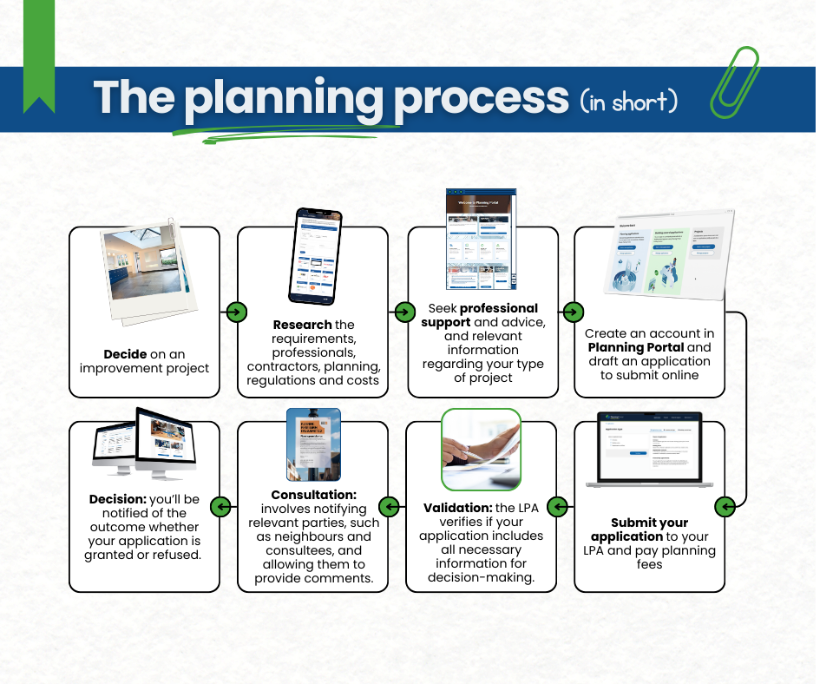Navigating the planning process

Navigating the planning process can be complex, but with Planning Portal’s expert tools, guidance, and support, applicants can better understand requirements, avoid common pitfalls, and move smoothly through each stage - bridging the gap between homeowners, developers, and local planning authorities.
The process:
While every project is different, most planning applications follow the same set of key stages. Here’s a straightforward outline of what the process usually looks like.

For many homeowners and developers, the planning application process can be seen as just another step in a long list of things to manage. But it’s a step that really matters. Planning rules and policies, including permitted development rights and local variations, exist to make sure our homes, neighbourhoods, and towns grow in the right way, and understanding them early can save a lot of time and frustration later.
If you’ve caught recent headlines, planning applications are on the rise, with a 30% increase in the UK, compared to 2024 (The Planner). This means councils are under increasing strain and planning teams are dealing with a heavier workload, creating a backlog.
That’s where we come in. Through Planning Portal, we help make the process easier to navigate. We provide the tools, guidance, and support to keep things moving - bridging the gap between applicants and local planning authorities so everyone can get to the finish line more smoothly.
Things you should know before starting your application
The planning system has a lot of moving parts, but knowing the basics can make the process much easier to follow. Here are a few essentials every applicant should understand:
- Planning permission - Formal approval from your Local Planning Authority (LPA) for building work or changes of use that aren’t covered by permitted development rights.
- Permitted development - Certain types of smaller projects (like loft conversions or small extensions) that don’t need full planning permission but may still need to follow rules or building regulations.
- Validation - The LPA checks that your application has all the right documents, plans, and information before they start assessing it. If details are missing or incorrect, the LPA will get back to you, which may delay the application.
- Decision notice - The official document you’ll receive at the end of the process, confirming whether permission has been granted (and setting out any conditions).
- Appeals - If your application is refused, you may be able to appeal the decision through the Planning Inspectorate.
- Building regulations - Separate from planning permission; these make sure work is safe, energy efficient, and meets structural standards.
We share more simple definitions and step-by-step explainers over on our Facebook page, so you can build up your planning knowledge at your own pace. LINK
Where applicants get most stuck with the UK planning permission process:
In 2025 so far, we’ve heard thousands of applicants through the Planning Guidance Service. And we are seeing similar questions pop up:
- What documents are needed, and how detailed do they have to be?
- How much will it cost, and how do payments work?
- How long does the process take?
- Who do I contact if I am not sure what is happening?
The system can seem tricky, with applications varying in size and scope, and each Local Planning Authority having its own local planning requirements, with local development plans that applications will likely need to align with. For an applicant, it can at times feel overwhelming. For Local Planning Authorities (LPAs), it can feel like refereering too many games and not enough players. Fear not, we have some tips, tidbits and tools to help homeowners, business and local authorities navigate the ins and outs of the planning process as seamlessly as possible
How we bridge the gap between applicants and LPA’s
Let’s be honest – taking second hand advice from friends or believing outdated rules from family, isn’t the best route for planning applications. That’s where Planning Portal steps in. With curated, expert content, we make sure you get the right information, from trustworthy sources, every time.
Here’s a snapshot of what we’ve got for you:
- Interactive House - A digital, clickable tool that lets you explore room by room, as well as outside spaces. Discover how permitted development rights and building regulations apply in each area, see what’s allowed (and what isn’t), and find out how to get started.
- Common Projects - A go-to hub for guidance on all sorts of typical household projects, from EV chargers and extensions to fences, flues, and more. It’s the starting place for most people.
- Sustainability Hub - Clear, simplified guidance to help you navigate sustainability legislation, greener building updates, and funding opportunities.
- User research – We regularly gather feedback from applicants to improve our tools and guidance, tell us what you think; we listen to every bit of feedback and would love to hear more.
Guidance for applicants
Our Planning Guidance Service answers hundreds of applicants queries every week, helping applicants understand the planning process and what’s required for their specific projects. Our experts take the time to talk through your questions, clarify rules, and guide you step by step so you can move forward with confidence.
Learn more.
Policy changes applicants should know about:
The planning landscape is shifting quickly. Here are some of the most significant recent updates:
- Planning and Infrastructure Bill (2025): councils can set fees locally, ring-fencing income for service improvements (Commons Library).
- Build-out reforms (2026): large housing developers will need to submit build-out statements, notices and progress reports (Planning Portal news).
- AI Extract tool: digitises historic planning documents to save officer hours, rolling out nationwide by 2026 (GOV.UK).
- Biodiversity Net Gain (BNG): at least 10% improvement now required for most new developments (Natural England).
- Local government restructuring: new unitary and combined authorities to streamline planning and governance (Commons Library).
Building control applications
Last year, we expanded our application services to include building control. Our Building Control Portal provides LPAs with a single, digital platform to manage applications efficiently. By combining extensive planning data with an intuitive submission system, applicants can submit applications directly through the portal, reducing paperwork, speeding up processing, and improving collaboration between LPAs and applicants.
Stay updated with Planning Portal's exclusive data and news.
At Planning Portal, powered by TerraQuest, we bridge that gap. We understand the needs of stakeholders across the industry, at all stages of development, and we provide the guidance, tools and support to make planning applications clearer, faster and less stressful. Whether you’re an applicant trying to figure out what form to submit, or a council officer trying to reduce a backlog, we are here to make your processes smoother and more streamlined.
Because at the end of the day, planning isn’t about bureaucracy - it’s about creating the places and homes we need. And that is something worth getting right.





